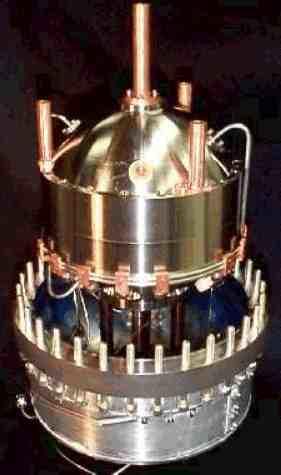Summary
By measuring the speed of sound in argon gas, we have determined thermodynamic temperature with unprecedented accuracy in the range 0 °C to 552 °C. Our results are used to improve the accuracy of platinum resistance thermometry.
Description

The basketball-sized resonator for the NIST Acoustic Thermometer, partially enclosed in its pressure vessel and inner oven.
Data from the NIST acoustic thermometer will form an improved basis for the equations used with platinum resistance thermometry, which is the primary mechanism to disseminate accurate temperature standards.
Objective:
To obtain measurements of thermodynamic temperature in the range between 273 K and 700 K with an uncertainty five times smaller than 1990 benchmark values.
Technical approach:
Temperature defined on the International Temperature Scale of 1990 (ITS-90) approximates the thermodynamic temperature. Unfortunately, in the range 273 K to 730 K, the ITS-90 was constructed by necessity from the average of two sets of constant volume gas thermometry data that are inconsistent, for unknown reasons, by much more than their combined uncertainties.
The NIST acoustic thermometer is based on the simple relation between the speed of sound of a monatomic gas and the thermodynamic temperature. By measuring ratios of the acoustic resonance frequencies within a nearly spherical cavity at an unknown temperature and at a temperature close to the triple point of water (defined as 273.16 K), we obtain the ratio of the argon speed of sound at these two temperatures. With simultaneous measurements of microwave resonance frequencies in the same cavity, we can account for the thermal expansion of the stainless-steel shell enclosing the argon.
Our thermometer has several novel features
- construction from inert metals and ceramics only,
- continuous gas purging of the resonator to minimize gas impurities,
- a gas-chromatography system to measure the impurities in the gas exiting the resonator,
- measurements on the ITS-90 with up to five long-stem standard platinum resistance thermometers,
- simultaneous measurement of microwave and acoustic resonances, and
- high-temperature acoustic transducers.
We have achieved our goal of reducing the uncertainty of thermodynamic temperature by a factor of five in the range 273 K to 552 K. Our data is in excellent agreement with recent radiometric measurements (at 700 K and above), other acoustic measurements (at 390 K and below), and one of the past gas thermometry results.
In 2008, we successfully developed techniques to perform precision acoustic measurements with a microphone at room temperature. The technique has pushed the upper limit of our data to 650 K.
Major Accomplishments
- In 2007, published results up to 552 K, resolving previous discrepancy that limited accuracy of the international temperature scale
- In 2008, completed measurements up to 650 K at unprecedented accuracy.

